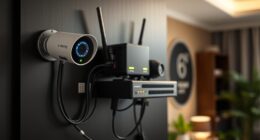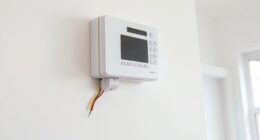Home security systems keep your home safe by using cameras, sensors, and alarms to monitor for unauthorized access. Entry sensors track doors and windows, alerting you if they detect an intrusion. Motion sensors minimize false alarms while working with cameras for real-time monitoring. Many systems connect wirelessly, making them easy to install and move. You can opt for DIY setups or professional monitoring, which offers 24/7 oversight. When an alarm triggers, trained personnel are ready to respond quickly, enhancing your safety. For more insights into optimizing your home security, there's plenty more to explore.
Key Takeaways
- Home security systems use sensors to monitor doors, windows, and movement, sending alerts to a central hub when unauthorized access is detected.
- Security cameras and video doorbells provide real-time monitoring and allow remote communication with visitors or potential intruders.
- Motion sensors utilize infrared technology to minimize false alarms and can be integrated with cameras for enhanced surveillance.
- Environmental sensors alert homeowners to hazards like smoke or carbon monoxide, adding an extra layer of safety to the home.
Overview of Home Security Systems
Home security systems are designed to protect your home by using a combination of cameras, sensors, and alarms to detect and respond to potential threats. Many modern systems can be accessed remotely through smartphones, allowing homeowners to monitor their properties from anywhere in the world. One of the key home security system benefits is the added peace of mind it provides, knowing that any unusual activity will trigger an immediate alert or response. Additionally, these systems can often deter criminals, as the visible presence of cameras and alarms can make potential intruders think twice before approaching a protected home.
These security systems can include various components, such as sensors that monitor for unauthorized access or movement. When a sensor is triggered, it sends an alert to a central hub, which activates alarm systems and can notify monitoring services or your mobile app.
You have options when it comes to choosing a security system. DIY home security systems allow you to customize your setup without professional help, while other systems may come with professional installation. Wireless security systems are increasingly popular due to their ease of installation and flexibility.
Many modern systems also incorporate environmental sensors to detect hazards like smoke or carbon monoxide, enhancing your home's safety.
Moreover, home automation features allow you to control your security system remotely through a mobile app, providing peace of mind whether you're at home or away. By integrating these technologies, you can create an all-encompassing security solution that fits your lifestyle and needs, effectively deterring potential threats and protecting your property.
Key Components and Functions

Key components of security systems, like entryway sensors and motion detectors, work together to create a complete defense against potential threats.
Entry sensors monitor doors and windows, sending mobile alerts when unauthorized access is detected.
Motion sensors utilize infrared technology to identify unusual movement, minimizing false alarms and often integrating with floodlights and security cameras for enhanced protection.
Security cameras and video doorbells offer real-time monitoring and recording, deterring criminal activity while enabling remote viewing and communication with visitors from your mobile device.
Floodlights activate upon detecting motion, illuminating dark areas and further discouraging intruders.
Additionally, glass-break sensors detect the sound or vibration of breaking glass, instantly alerting you and monitoring centers to possible intrusions, providing an extra layer of security.
Together, these key components form a thorough home security system that keeps you informed and protected.
By utilizing mobile alerts and real-time monitoring, you can maintain peace of mind, knowing your home is secure even when you're away.
Each component plays an essential role, ensuring that your home remains a safe haven against potential threats.
Types of Home Security Systems

Several types of home security systems are available, each designed to meet different needs and preferences.
If you prefer hands-on control, DIY systems let you install and monitor your security setup yourself. These often come with wireless systems, which are easier to install and can be moved around as needed.
On the other hand, if you want peace of mind, consider professional monitoring. With these systems, a security company installs the system and offers 24/7 oversight, often including features like mobile alerts.
Smart home security systems enhance your safety by integrating with internet-connected devices, allowing you to receive notifications and control your system remotely.
If you're looking for a budget-friendly option, unmonitored systems enable you to self-monitor without any subscription fees. You can choose from various components like entry sensors, motion detectors, and a video doorbell to customize your system.
Popular brands like SimpliSafe and Ring Alarm offer packages that cater to different security needs and budgets, ensuring you find the perfect fit for your home.
Monitoring and Emergency Response

Monitoring services provide round-the-clock surveillance, ensuring trained professionals can swiftly respond to any alarms and alert emergency services when needed. These professional monitoring services are vital for enhancing your home security, as they allow for immediate communication with emergency responders.
Here's a quick overview of how monitoring works:
| Feature | Description |
|---|---|
| Real-Time Alerts | Notifications sent to you via calls, texts, or apps. |
| Trained Personnel | Experts ready to handle alarm signals and emergencies. |
| Response Times | Quicker responses compared to unmonitored systems. |
| False Alarms Reduction | Verification processes minimize unnecessary dispatches. |
In case of a security breach, trained personnel can confirm alarms and notify police, fire, or medical responders, greatly improving response times. This quick action is essential for mitigating damage or harm during incidents. By investing in professional monitoring services, you're not only protecting your home but also ensuring a rapid response to any emergency situations that may arise.
Benefits and Cost Analysis

Investing in a home security system not only boosts your safety but can also save you money in the long run. By installing home security systems, you can reduce the risk of burglary, as homes with these systems are 300% less likely to be targeted. This reduced risk doesn't just protect your valuables; it can also lead to lower insurance premiums, potentially saving you up to 20%.
Additionally, many security companies offer transparent pricing with no hidden fees, making it easier for homeowners to budget for their safety.
While the average installation cost is around $400, you'll need to evaluate ongoing monitoring fees, which range from $10 to over $60 monthly, depending on the service level you choose. Some homeowners opt for DIY installation to cut initial costs, but professionally monitored systems provide additional peace of mind.
Moreover, regular maintenance and upgrades can enhance your system's effectiveness, helping you avoid expensive repairs or losses due to security breaches.
When you weigh the costs against the potential savings and the emotional benefit of feeling safe, a home security system proves to be a wise investment. Overall, a thorough cost analysis reveals that the benefits of security far outweigh the expenses.
Frequently Asked Questions
How Does a House Security System Work?
A house security system monitors entry points and detects movement, alerting you to any unauthorized access. It connects sensors and cameras, sending notifications to your devices, ensuring you're always aware of your home's safety.
What Is Required for a Home Security System?
To build your fortress of safety, you'll need a central hub, sensors for doors and windows, motion detectors, security cameras, a reliable power source, and internet connectivity for remote monitoring and alerts.
How Does Wireless Home Security Work?
Wireless home security systems use Wi-Fi or cellular signals to connect devices. You'll receive alerts from motion sensors and cameras, allowing you to monitor your home remotely and store footage securely in the cloud.
Do Home Security Systems Work Without Wi-Fi?
Yes, home security systems can work without Wi-Fi. They often use cellular networks or wired connections to stay operational, ensuring you receive alerts and monitoring, even in areas with poor internet connectivity.
Conclusion
To sum up, investing in a home security system isn't just about protecting your belongings; it's about safeguarding your peace of mind.
Did you know that homes without security systems are 300% more likely to be burglarized? By taking proactive steps to secure your home, you can greatly reduce the risk of becoming a statistic.
So, whether it's through alarms, cameras, or monitoring services, you're not just investing in equipment; you're investing in your family's safety.









